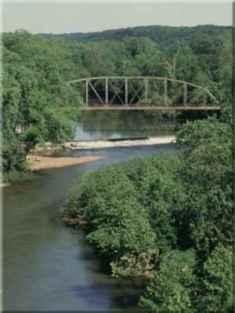Bourbeuse River Fishing Spot
- Elevation: 470'
- Last Modified By: vinny60 on 09/16/09 12:41 PM
- Ask about Bourbeuse River in our Fishing Forums
Photos
Fish Species
Comments
-
Smallmouth bass can be caught on a variety of artificial lures such as spinner baits, jig and plastic grub combinations, crankbaits, and plastic worms. The Bourbeuse tends to be cloudy, so lures that are easily seen should be selected. Live bait such as crayfish, earthworms, minnows, and insect larvae is often very productive. Largemouth bass are a sporting alternative to smallmouth bass. Largemouth bass are often the largest bass species present in the Bourbeuse River in most pools greater than 3 feet in depth. Also, spotted bass have become increasingly common in the Bourbeuse in recent years. Largemouth bass prefer more woody habitats, sluggish weedy backwater areas, and slightly warmer waters. They can be caught on baits similar to those used for smallmouth bass. Spotted bass tend to prefer the main channel zone, but angling techniques effective for smallmouth and largemouth bass also work on spotted bass. Walleye and sauger can be caught on similar baits. Having a preference for live baits, walleye will strike minnows, earthworms, and leeches. Fishing crankbaits and deep-running plugs in deep pools is an effective summer strategy. Because walleye are active at night, try baits that reflect the available light and produce some sound. Spring fishing strategies should include fishing bridge abutments and rock piles that are walleye and sauger magnets. Jigs and minnow combinations can also be trolled in large pool areas with bridge abutments.
Bourbeuse River Description
The Bourbeuse River watershed is located within the northeastern quarter of the Ozark Highlands. The main stem of the Bourbeuse River winds northeasterly through Phelps, Gasconade, and Franklin counties to join the Meramec River, and its watershed additionally encompasses portions of Maries, Osage, and Crawford counties. The Bourbeuse River is 147 miles from mouth to headwaters, and the lower 132 miles have permanent flow. The Bourbeuse River watershed drains 843 square miles. Bourbeuse River game fish commonly sought by anglers are smallmouth bass, largemouth bass, channel catfish, flathead catfish, rock bass, and panfish. A cool-water fish, the walleye, is also found in the river in reaches below the dam at Noser Mill. Black bass, which include smallmouth bass, largemouth bass, and the spotted bass, have been extensively studied in the river especially in reaches below Highway 185 (Noser Mill). The daily limit for black bass in streams is six. Smallmouth bass are common with a good portion of fish greater than 12 inches, the minimum length for the harvest of black bass. Large smallmouth bass prefer deep water with some current, in particular next to cover such as boulders, logs, or bedrock. Smallmouth bass prefer temperatures from 60E F to no more than 80E F. This species feeds optimally at 70-75E F. There is at least one known commercial campground, and probably others, on or rnear the Bourbeuse River. Abundant natural campsites can be found all along the river, but many are on private property. If land is posted, then do not camp there without having first obtained permission from the rightful owners. There are at least two known commercial outfitters offering rentals, shuttles and/or river information on or near the Bourbeuse River. The Bourbeuse River is home to most of the popular sport fish found in Missouri. The river tends to be turbid, and because of the relatively low gradient, is slower moving than other Ozark streams. Most float anglers fish the Bourbeuse in the spring, before base flows limit their ability to move between access points. Smallmouth bass, largemouth bass, spotted bass, rock bass, channel catfish, flathead catfish, walleye, redhorse and suckers, longear sunfish, bluegill, black crappie, and white crappie are among the most popular species sought by anglers.
